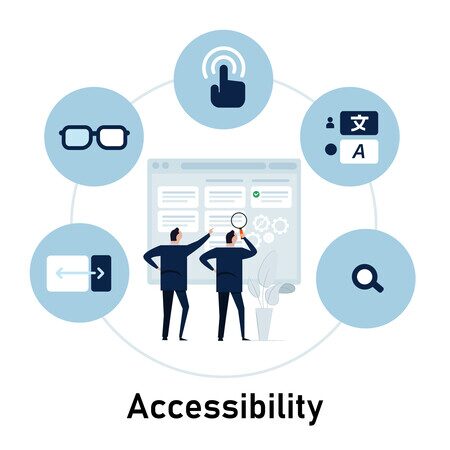An engaging website is an excellent way to drive exposure and sales for a business, but its effectiveness relies on users’ experiences. This is where website accessibility comes into play.
What is Website Accessibility?
In a nutshell, website accessibility is about engaging every site visitor regardless of ability or disability.
Isn’t a Public Website an Accessible Website?
Public websites are those that don’t need passwords. Public and accessible are two different things.
Why is Website Accessibility Important?
Imagine that a color blind person cannot read a graph or chart on your webpage because the colors are difficult to read. So, even though the graph or chart shows that your firm’s products are beneficial, that color blind person is missing vital information and choose a competitor’s product, instead. Ouch!
That is but one example. There are others, but let’s focus on the bigger picture. Roughly 20% of the population has a physical, sensory, or cognitive issue that means that information isn’t accessible. 20%.
What is the Goal of Website Accessibility?
The goal is making all information on a website accessible to everyone. When that isn’t feasible, the goal becomes making all essential features of a site accessible to the greatest range of visitors.
How does Website Accessibility Work?
The “big five” below are a bit technical, so we will explain briefly. (Please, contact us for more detail.)
- Adding accurate ‘alt text’ to images. This is alternative text to supplement photographs, charts, graphs, and illustrations. Its purpose is to describe what a person with average vision sees. This information can be viewed by anybody who knows how to see it. Most site visitors elect to bypass this information. However, visitors with visual impairments will read it.
- Including descriptive captioning for all video content. This is similar to the idea above about alternative text. It is different, however, in that an image usually captures a single idea while a video might capture several ideas. Again, the average visitor usually bypasses this additional information but those with visual impairments will use it.
- Building a logical organizational structure that can be easily navigated by keyboard. Think of keyboard shortcuts in a word processor, such as Control-B for bold or Control-I for italics. Some site visitors navigate a website by way of a keyboard because they have difficulty using a mouse. For these visitors, the keyboard is an integral part of their experience. Overlooking them might mean losing sales opportunities.
- Making all text content fully readable without CSS. Time for a little acronym with a big impact. CSS is the acronym for Cascading Style Sheet. Ensuring that text is readable without CSS provides another opportunity to engage site visitors.
- Using valid HTML throughout. HTML is the acronym for HyperText Markup Language. Using valid HTML is the means of ensuring that a website will work on the greatest range of devices for the greatest range of site visitors.
Are there other Benefits?
Beyond engaging the greatest number of site visitors, search engines can more readily index accessible sites. Plus, not every visitor has a new computer high-speed internet. For those with older technology or slower connection speeds, accessible content makes it easier for them to access vital information even though they might not be able to view a full-length video on a site or view some of the visually stunning content that most visitors can see.
Are there Restrictions?
Website Accessibility provides options to those who might otherwise have difficulty viewing a site. Sites that aren’t accessible are restrictive in that they keep some visitors from fully engaging in the content.
Remember, roughly 20% of the population has a physical, sensory, or cognitive issue that means that makes accessing information extremely difficult, if not outright impossible.
Are there Legal Implications?
A website with limited accessibility might breach disability discrimination laws, such as the American Disabilities Act, which can introduce legal risks and costs.
Is Your Website Accessible?
Comit’s team of experts can identify opportunities to improve your website’s accessibility, recommend solutions, and deploy them as part of a major project or as a series of smaller initiatives.
What Next?
Contact Comit Developers now for a free consultation about website accessibility.


